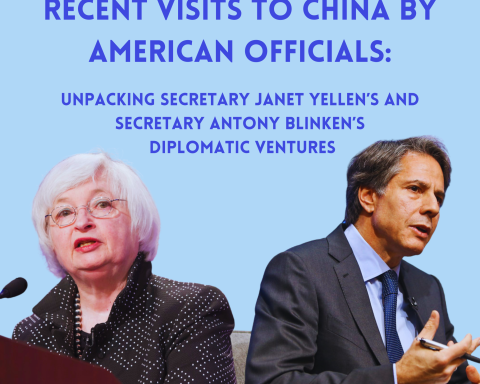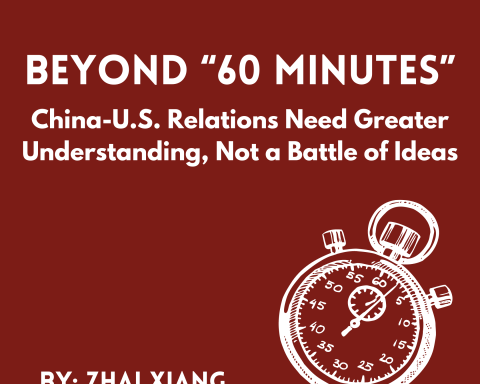“DEATH BY CHINA is right on.”
The web page is cluttered with various animated graphics and various endorsements. At the top of the page sits a quote from Donald Trump. “This important documentary depicts our problem with China with facts, figures and insight. I urge you to see it.” The endorsement is for Death By China, a 2012 documentary based on a book by the same name. The author is Peter Navarro, a “bestselling author and filmmaker” according to the description on the page, as well as a professor of business at the University of California, Irvine. The documentary (narrated by Martin Sheen) “confronts the… increasingly destructive economic trade relationship with a rapidly rising China.” Early on the film, it is made clear that objectivity is not one of Navarro’s main concerns. In one graphic sequence symbolizing the film’s message, an army knife tagged “Made in China” plunges into the American heartland in slow motion. Blood seeps out from underneath.
In the midst of a wildly unpredictable election campaign season, Republican candidate Donald Trump’s platform on China has remained one of the few emblems of consistency. His belligerent stance on China, particularly regarding what he refers to as its ‘unfair policies’ on trade, manufacturing and currency manipulation. One of his most controversial proposals has been to threaten raising tariffs on Chinese imports by as much as 45%. His promises to regain ‘lost’ American manufacturing jobs has been instrumental in winning support among many working class American voters. Much of Trump’s platform on China echoes the ideas proposed by Navarro – and while his position within the Trump campaign is unclear, there is no doubting his influence on many of Trump’s core policy proposals.
After graduating from Tufts with a B.A. in 1972, Peter Navarro went on to serve in the Peace Corps in Thailand, an experience which he states first began his ‘fascination’ with China. He went on to receive a Master degree in Public Administration and Ph.D in economics from Harvard University, then joined the staff at the University of California, San Diego, later moving to the Irvine campus. As a professor, he became involved with the growth-management movement in San Diego, gaining local recognition as the founder and chairman of the organization ‘Prevent Los Angelicization Now!’ (PLAN!) PLAN! aggressively pushed for greater limits on the expansion of the city of San Diego and lobbied for environmental protections. Using the reputation that he garnered from his activism, he launched a campaign for the mayor of San Diego in 1992, running against former councilman and county supervisor Susan Golding. The contest took place amidst a period of severe economic recession for the city, and was characterized by bitterness and negativity on both sides. Without previous political experience to rely upon, Navarro staked his campaign on his work in growth-management activism as well as his position as a political outsider. He painted himself as the ‘jobs candidate’, and as an ‘agent of change’, and attacked his experienced opponent for being in the ‘pockets of developers’. He narrowly lost that race.
Over two decades after his failed mayoral campaign, Navarro is back in the political spotlight. He has appeared on TV numerous times and has written articles in support of Republican presidential nominee Donald Trump. He denounced a Moody’s analysis of Trump’s economic plan as a ‘hit piece’, gaining widespread publicity in the process. He has argued that Trump is the ‘only candidate’ that understands the seriousness of the threat of China. The similarities of Trump’s campaign to Navarro’s own in 1992 are all too striking; Trump is a candidate embroiled in a bitter and negative race, he paints himself as an outsider to politics and as an ‘agent of change’, he has no previous experience in political office and relies upon recognition from his other activities, he promises to recover lost jobs and restore the economy, and he is running against an experienced opponent that he accuses of being in the pockets of the elite.
While the majority of Navarro’s past academic research have focused on the economics of energy, he began shifting his focus onto China with the publication of his book, The Coming China Wars: Where They Will Be Fought, How They Will Be Won (2006). “China’s breakneck industrialization is placing it on a collision course with the entire world”, reads the official description, “[The Coming China Wars] reveals the urgent, radical decisions that must be made to avoid catastrophe.” Controversial and divisive, The Coming China Wars set the path for Navarro’s entrance into the field of U.S.- China relations.
“Try to look past the author’s political bias and you’ll find that it really is an in-depth analysis,” wrote one reviewer on Amazon.
“Books with tempting titles such as The Coming China Wars appear to attract a large audience,” commented another, less sympathetic reader, “and thus contribute to a further misinformation of a readership that may lack the basic foundational knowledge to properly assess the message and arguments presented in such books.”
Navarro’s most prominent work came five years later, along with an even more provocative title. Death by China was released in 2011 and turned into a feature-length documentary film a year later. The film features commentary from a variety of politicians and researchers, spliced in with crude animations that illustrate China’s threat to the United States. The message of the film (and book) is simple: China has been using illegal methods to gain an unfair competitive advantage with the United States, and the U.S. government has been weak in its response to stop them.
The solution: Stand up to China, stop its currency manipulation, IPO theft, loose environmental standards, slave-like exploitation of its workers and lax safety standards. Once the playing field is even, the jobs will return to the United States and restore its manufacturing sector. The film also delves into discussion of various other topics, such as the totalitarian nature of the Chinese Communist party and its human rights abuses, and concerns about the rising threat of China’s military. But at the heart of the film is the economy, and it is easy to understand why its message is so appealing to certain audiences. It distills the narrative down to a simple duality of good and evil, it provides easy targets for blame, and it promises a simple solution for restoring lost American jobs and prosperity.
Donald Trump understands the power of this distorted narrative, and he has seized upon it to bludgeon his way towards the Republican nomination. But it is Navarro and others like him that enable a politician like Trump to push forth a twisted version of reality for their own political gain. It is easy to overlook the fact that trade between the U.S. and China have been overall greatly beneficial to both countries, when on an individual level not everyone has felt those benefits. It could also even be easy to brush aside America’s hypocrisy when we decry China’s ‘illegal’ manufacturing subsidies while providing the same to our own agricultural sector. But it is difficult to overlook the viciously antagonistic view of China that persists throughout all of Navarro’s books, documentaries and articles on China. Underlying all his writings is a sense of hysteria and desperation that China must be dealt with, that we must prepare for outbreak of actual state conflict, that extreme measures must be put into place in order to prevent the destruction of America. It is clear from the onset of Death by China that it will not concern itself with maintaining objectivity, and separating the facts from overblown hyperbole in his work becomes a strenuous task. It is also clear that providing evidence for many of his claims is not of top concern. In one instance in Death by China, Navarro infers that China ‘can field’ 1,000 J-20 fighters. The latest report by the Department of Defense[1] suggested that J-20 fighters are still under development. Furthermore, there is no evidence to support the fact that China is, or even is remotely considering, building 1,000 J-20 fighters.
In an election cycle where facts have made way for narrative, the popularity of Navarro and Trump’s ideas is perhaps not so surprising. Such thinking is not only dangerous, but ultimately will prove the most fatal to the same voters that have put their faith in these ideas. ‘Standing up’ to China won’t bring back lost jobs – but it will hurt the working class who rely the most on cheap Chinese goods. Forget the propaganda and fear mongering – on both side. America needs to not see China as a deadly enemy, but a rising power that must be understood properly and is really not all that different from America itself.
By: SUNGWOO PARK
[1]http://www.defense.gov/Portals/1/Documents/pubs/2016%20China%20Military%20Power%20Report.pdf




